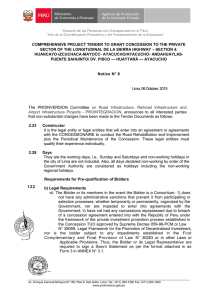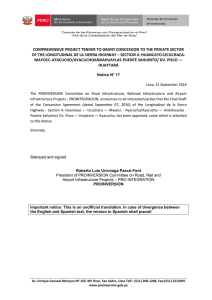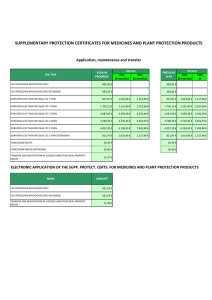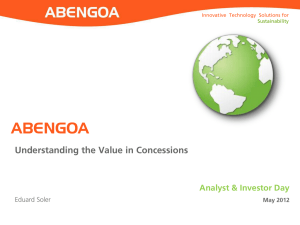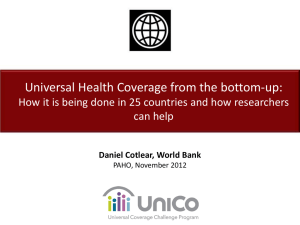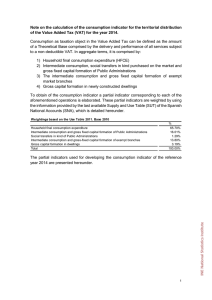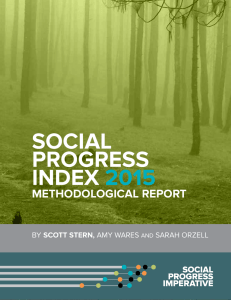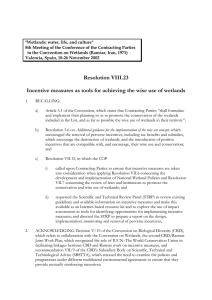ITS-related transport concepts and organisations` preferences for
Anuncio
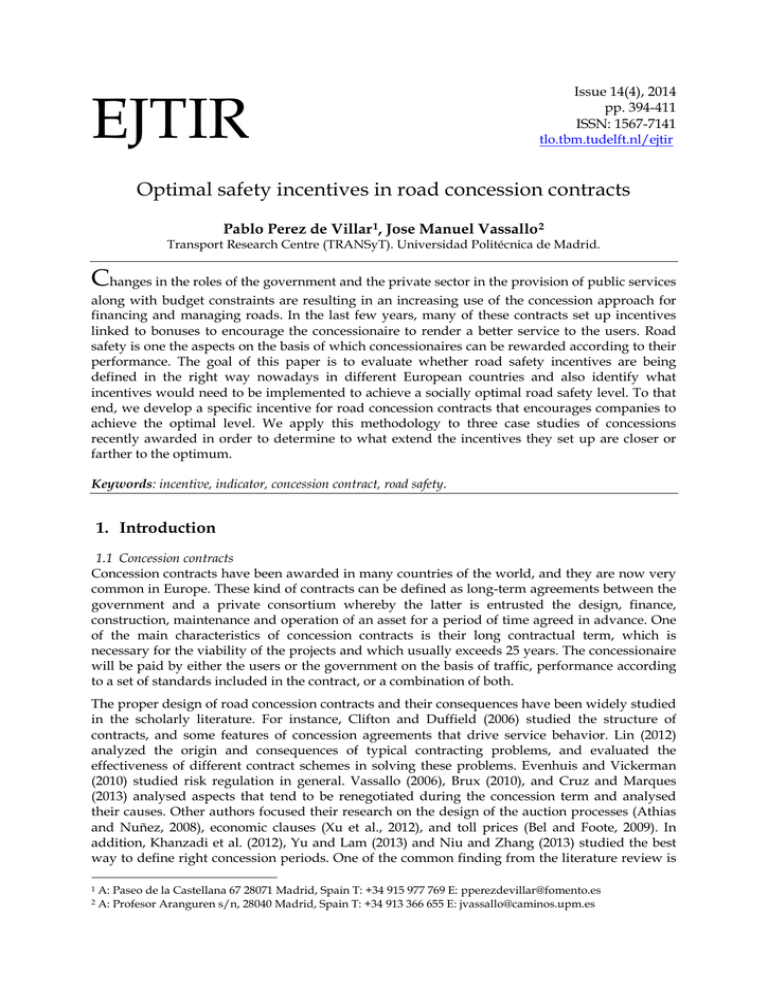
EJTIR Issue 14(4), 2014 pp. 394-411 ISSN: 1567-7141 tlo.tbm.tudelft.nl/ejtir Optimal safety incentives in road concession contracts Pablo Perez de Villar 1, Jose Manuel Vassallo 2 Transport Research Centre (TRANSyT). Universidad Politécnica de Madrid. Changes in the roles of the government and the private sector in the provision of public services along with budget constraints are resulting in an increasing use of the concession approach for financing and managing roads. In the last few years, many of these contracts set up incentives linked to bonuses to encourage the concessionaire to render a better service to the users. Road safety is one the aspects on the basis of which concessionaires can be rewarded according to their performance. The goal of this paper is to evaluate whether road safety incentives are being defined in the right way nowadays in different European countries and also identify what incentives would need to be implemented to achieve a socially optimal road safety level. To that end, we develop a specific incentive for road concession contracts that encourages companies to achieve the optimal level. We apply this methodology to three case studies of concessions recently awarded in order to determine to what extend the incentives they set up are closer or farther to the optimum. Keywords: incentive, indicator, concession contract, road safety. 1. Introduction 1.1 Concession contracts Concession contracts have been awarded in many countries of the world, and they are now very common in Europe. These kind of contracts can be defined as long-term agreements between the government and a private consortium whereby the latter is entrusted the design, finance, construction, maintenance and operation of an asset for a period of time agreed in advance. One of the main characteristics of concession contracts is their long contractual term, which is necessary for the viability of the projects and which usually exceeds 25 years. The concessionaire will be paid by either the users or the government on the basis of traffic, performance according to a set of standards included in the contract, or a combination of both. The proper design of road concession contracts and their consequences have been widely studied in the scholarly literature. For instance, Clifton and Duffield (2006) studied the structure of contracts, and some features of concession agreements that drive service behavior. Lin (2012) analyzed the origin and consequences of typical contracting problems, and evaluated the effectiveness of different contract schemes in solving these problems. Evenhuis and Vickerman (2010) studied risk regulation in general. Vassallo (2006), Brux (2010), and Cruz and Marques (2013) analysed aspects that tend to be renegotiated during the concession term and analysed their causes. Other authors focused their research on the design of the auction processes (Athias and Nuñez, 2008), economic clauses (Xu et al., 2012), and toll prices (Bel and Foote, 2009). In addition, Khanzadi et al. (2012), Yu and Lam (2013) and Niu and Zhang (2013) studied the best way to define right concession periods. One of the common finding from the literature review is 1 2 A: Paseo de la Castellana 67 28071 Madrid, Spain T: +34 915 977 769 E: [email protected] A: Profesor Aranguren s/n, 28040 Madrid, Spain T: +34 913 366 655 E: [email protected] EJTIR 14(4), 2014, pp.394-411 Pérez de Villar and Vassallo Optimal safety incentives in road concession contracts 395 that special attention should be paid to the way of monitoring the performance of concessions because of its social impact. 1.2 Quality management in infrastructure contracts In perfect market conditions, quality is self-regulated so companies provide services adjusting quality and price to demand. If customers are willing to pay for improving quality and that is profitable for private companies, they will have incentives to carry it out, as by so doing they will increase their profit. Nevertheless, in roads granted trough concession contracts, this free quality management becomes problematic for several reasons. First, road concession prices are usually regulated by the government, so the concessionaire has little incentive to improve quality above the minimum standards required. Second, demand elasticity to road quality is barely sensitive. And third, due to the nature of this service, users may not value the improvements or even they cannot perceive them, making it harder to justify price increases. Due to these constraints, it follows that the quality in road concessions cannot be self-adjusted by the market. Specifically, quality cannot depend upon the relation between rates and demand. Therefore, in order to obtain the optimal quality level, the government has to introduce the right incentive to the concessionaire in the contract by introducing incentives tied to the fulfillment of certain indicators. These incentives should encourage the private sector to provide a more suitable quality level for the society. Road safety is one of the most important aspects influencing the quality of a road because of its social impact. Although the characteristics of the road infrastructure—both design, maintenance and operation—are not the only cause of traffic accidents, it is widely demonstrated (Elvik et al., 2009) that carrying out measures over the infrastructure can reduce significantly the number of accidents and their consequences. Therefore, many aspects to improve road safety are manageable by the concessionaires or, at least, the concessionaire can have an influence to a certain extent. However, the way to introduce adequate road safety incentives to achieve an optimal safety level from the social point of view in such contracts has been scarcely analyzed. Recently, Goncalves and Gomes (2012) designed a model reflecting the incentives of the concession company to maintain a highway concession in proper conditions, whilst maximizing profits at the same time. However, they did not focus their analysis on the social benefit; neither did they include road safety specifically. Rangel et al (2013) studied the safety levels of highways in Spain, and found out that toll highways with safety incentives are safer than toll highways without incentives, but she did not analyzed what should be the optimal formulation of safety incentives. 1.3 Aim and structure of the paper The aim of this paper is: first, to provide a careful analysis of the trade-offs associated with costs and social benefits regarding road safety; second, to discuss qualitative and quantitative constraints of introducing road safety indicators in concession contracts; third, to provide an incentive scheme and apply it to different case-studies; and fourth, to evaluate whether current road safety incentive adequately encourage the concessionaire to reach the optimal social benefit. The paper is structured in five sections. After this introduction, the second section summarizes how road safety has been regulated in concessions contracts in Europe in order to identify good practices in the definition of indicators and incentives. The third section explains the methodology aimed at defining an optimal incentive approach. The fourth section implements the methodology previously defined to three case studies in order to assess whether incentives have been defined in the right way or not. The last section discusses the results, summarizes the main conclusions, and points out future research areas. EJTIR 14(4), 2014, pp.394-411 Pérez de Villar and Vassallo Optimal safety incentives in road concession contracts 396 2. Road safety incentives in existing concession contracts 2.1 Overview In this research, we have analysed more than 50 road concession contracts from different European countries in order to evaluate how road safety aspects are introduced in them, and identify whether they encourage companies to improve road safety or not. When indicators and incentives have been found, a deep analysis has been carried out to identify their characteristics. Incentives are rewards agreed in advance between a contactor and a provider, with the aim of encouraging the provider to supply an extra added value in the services for which it is being paid, so as both of them, contractor and provider, obtain benefits (Blyth , 1969). Incentives in concession contracts are usually tied to performance indicators on the basis of which it is possible to reward the concessionaire when a good service is provided. Moreover, these indicators enable the government to monitor to what extent targets for good management are reached, and also measure their evolution over time. The first finding is that all concession contracts address road safety in the management of roads in a direct or indirect way. For instance, as others found before (Bousquet and Fayard, 2001), all concession contracts include requirements about the design, maintenance and operation of the road taking into account safety issues. In this regard, large differences have also been observed between recent contracts, and traditional ones, those awarded before 2000. These contracts regulate the quality of the road in a very simple way, without including either indicators or incentives. In almost all traditional contracts, road safety is included within the maintenance requirements, or as a general result derived from them. Some of the traditional contracts set minimum standards related to the condition of the road which, if not met, could involve penalties imposed by the government (Heggie and Vickers, 1999). Those kinds of contracts are called "MOMS", from Minimum Operational Maintenance Standards (Schliessler and Bull, 1994). Although in recent contracts there has been an evolution in the design of their provisions related to quality, most of the road concessions in operation are still regulated by traditional contracts due to their long term nature. However, recent contracts in several countries explicitly include road safety incentives tied to performance indicators In these countries, this practice has become common for new contracts. Table 1 shows the countries where there are contracts with specific road safety incentives. However, recent concession contracts in several countries include road safety incentives tied to performance indicators, so contracts are becoming more complex(Cruz and Marques ,2012; Vassallo and Gallego, 2005). In these countries, the practice of including specific road safety indicators has become common for new contracts. Table 1 shows in which countries there are contracts with specific road safety incentives and in which ones there are not. Table 1. Breakdown of the introduction of Road Safety Incentives Countries where there are concession road contracts with specific road safety indicators and incentives Finland Hungary Norway Portugal Spain United Kingdom Countries where there are contracts with other kind of requirements related to road safety Austria Belgium Bulgaria Czech Republic Denmark Germany Greece Ireland Italy Netherlands Poland Romania As it can be observed, in Spain, Finland, Hungary, Norway, Portugal and United Kingdom, there are concession contracts with specific road safety incentives tied to performance indicators. On the other hand, France, despite being a country with a large tradition in concessions, does not EJTIR 14(4), 2014, pp.394-411 Pérez de Villar and Vassallo Optimal safety incentives in road concession contracts 397 include any safety indicator in their contracts. Italian concession contracts introduce price-caps tied to road safety indicators in such a way that the concessionaire is allowed to set higher tolls if safety ratios are better. In Ireland, concession contracts include some interesting road safety indicators but they do not provide bonuses. In other countries, like Denmark, the Netherlands and Belgium, there are new and sophisticated contracts, but they have neither incentives nor indicators according to the definition given above. Those countries with less tradition in developing concessions but close to each other have implemented similar approaches. For instance, Germany, Austria and Poland have similar contract requirements, but again they do not include specific road safety incentives tied to performance indicators. 2.2 Road safety indicators in existing contracts In the contracts analysed, we have observed how the indicators used to evaluate the improvement of road safety are quite heterogeneous. There are differences from the initial accident data to the final formula utilised. Specifically, concerning the initial accident data, indicators of different contracts are based on: number of injuries, number of fatalities, number of personal injury accidents, number of fatal accidents, and combination of number of light accidents, serious accidents and fatal accidents. Most of the contracts analysed include only one of these indicators, although there are some exceptions. For example, the latest concessions awarded by the Spanish government included two indicators based on both the number of injuries and the number of fatalities. On the other hand, including the exposure to risk (expressed by traffic) is a generalized practice. In fact, only the first British shadow toll roads contracts did not introduce traffic since they used the absolute number of personal injury accidents as indicator. The rest of the contracts analysed take into account exposure to risk in a way or another. In most of the cases the initial accident data is divided by the volume of annual traffic, usually measured in terms of millions or billions of vehicles-kilometres. The E18 road (Muurla–Lohja) in Finland, the M6 road in Hungary, several concessions in Portugal (the IP-4, for instance) and the latest ones awarded in Spain use this methodology. The advantage of introducing the exposure to risk (traffic) explicitly is that distortions in road safety results are reduced. In many concession contracts the assessment of the indicator is done by comparing similar roads, in terms of traffic, number of carriageways, type of surroundings, etc. With this approach it is possible to control for the global evolution of casualties which is notably decreasing in the EU due to many factors, most of them not manageable by the road operator. Some road contracts where the indicator is set in this way are E-18 road (Grimstad– Kristiansand) in Norway, the latest PPP roads awarded in the United Kingdom (for example, A1 & M25) and some others in Spain (like the M-407 motorway). Other contracts, such as some concessions awarded by the regional governments in Spain, do not compare the performance with other roads, but they just compare the evolution over time of the indicator for a specific road stretch. This does not seem to be a good practice because as mentioned above safety tends to improve over time by measures not manageable by the road operator. Regarding the period of time considered, concession contracts that compare the results with other roads always adopt the performance in one year. On the other hand, concession contracts that compare the evolution of the indicator over time use one, two or three years. Perhaps the most representative indicator is the one included in the Finish E18 (Muurla-Lohja), the Spanish M-407, and the Portuguese IP-4. This indicator measures the proportional difference between the risk index (number of personal injury accidents related to traffic) of the road and the risk index of similar roads, as it is expressed in the following formula. EJTIR 14(4), 2014, pp.394-411 Pérez de Villar and Vassallo Optimal safety incentives in road concession contracts 𝑅𝑅𝑅𝑅𝑅𝑅 = Where: 𝑅𝑅𝑅𝑅𝑠𝑠𝑠𝑠 −𝑅𝑅𝑅𝑅 𝑅𝑅𝑅𝑅𝑠𝑠𝑠𝑠 398 (1) • RSI: road safety indicator • RI sr : road safety index of similar roads (number of personal injury accidents/volume of traffic in veh-km; both for the year of assessment in all similar roads of the region) • RI r : road safety index of the road (number of personal injury accidents/volume of traffic in veh-km; both for the year of assessment but only in the concession road) 2.3 Definition of road safety incentives in existing contracts Basically, there are two kinds of incentives used in concession contracts: incentives related to the duration of the concession, and incentives related to additional payments. Both of them have an effect on the economics of the road operator. In fact, once an incentive has been set, it would be possible to find an equivalent alternative in terms of net present value combining these three variables: fares, expected traffic and concession period. Incentives related to the extension of the contract duration are more common than incentives related to payment increases. Examples of the first one can be found in the latest toll roads awarded by the Spanish Government. In these concessions, the road operator can be granted one or two additional years of operation if safety indicators remain below an accident benchmark for similar roads. As far as incentives related to payments are concerned, they can be divided into two groups: those that link the assessment of the indicator to bonuses and penalties regardless of the traffic volume, and those for which bonuses and penalties depend on the traffic volume. Contracts in the United Kingdom and Hungary belong to the first group. In these contracts there is a linear relationship between the evolution of the road safety indicator and the penalties/bonuses for the road operator, with a maximum cap in both cases. In the rest of the contracts analysed, the assessment of the indicator was linked to the annual payment. In other countries such as Finland, Portugal and also Spain, incentives are usually set as a percentage of the payments to be made to the concessionaire depending mostly on traffic. For example, in Spain, some concessions awarded by regional governments contain penalties and bonuses set up as a percentage of the annual payment depending on the results of the performance indicator. These percentages are lower in absolute terms if the results are positive than if they are negative. In other words, the bonuses are smaller than the penalties. For example, for values of the road safety indicator around -60% the penalty is approximately 6% of the annual payment. On the contrary, if the outcome of the indicator is +60% the bonus represents about 4%. The reason behind this imbalance is not justified in the contracts. In any case, positive incentives to improve road safety are apparently very low. For instance, in the contract of the AG-11 highway in Spain the bonus is only 0.8% of the annual payment for reductions of the road safety risk index between 35% and 50%. 3. Methodology to define optimal safety incentives 3.1 Cost-benefit analysis of measures for improving road safety: As it has been mentioned above, concessionaires are able to manage many aspects that affect the safety level of the road, i.e. maintenance, design of the infrastructure and roadsides, and even partially traffic management and emergency services. Improving these aspects to achieve a higher safety level will improve the gross social benefit, but it will also imply the additional cost of the measures to be implemented. In this respect, it must be taken into account that, from the socio-economic point of view, little investment in road safety can be as counterproductive as squandering resources in disproportionate measures. The challenge is to find the optimal point. EJTIR 14(4), 2014, pp.394-411 Pérez de Villar and Vassallo Optimal safety incentives in road concession contracts 399 This approach could be applied to other aspects managed by the concessionaire, because every service rendered is related to a certain social benefit. 8 10 Road safety measures benefit-cost curve 2 4 6 Cost of the measure (M€) In general, a road manager can reach different road safety levels by carrying out different measures. From the economic point of view it is desirable to identify the most efficient ones. In a benefit-cost Cartesian diagram, all these actions define a curve that can be named "benefit-cost curve of the best road safety measures". As it can be seen in figure 1, this curve represents, for different road safety levels, the cost of different measures to achieve them. The diagram on the left represents several measures to improve road safety (A1, A2, B1, etc.) with different costs for each road safety level. These different measures are supposed to be independent of each other. The diagram on the right shows the aforementioned curve connecting only those measures of lowest cost for each road safety level. 2 4 6 8 10 Social gross safety benefit (M€) Figure 1. Theoretical relationship between gross social benefit and gross social cost for different measures to achieve better road safety levels Benefit-cost curves of the best road safety measures can be determined for a road network from the basis of the costs and efficiencies of an historical panel of measures in road sections of similar characteristics and similar safety levels. In this research the shape of the curve has been estimated for rural one-carriageway Spanish National Road Network for stretches of 1 km with an AADT of 10,000 veh. and an average of road safety risk index of 40. The following 8 types of well-targeted actions to achieve a better road safety level in these roads have been considered: highway construction, improvement of the horizontal alignment, enhancement of vertical alignment, smoothing road sides, improving pavement friction, rumble strips in shoulders, installation of curve warning signs with sequential flashing and installation of chevron signs. The cost for a lifespan of 30 years of each measure has been taken from the database of the General Directorate for Roads of the Spanish Ministry of Public Works and Transport. Furthermore, for the calculation of social benefits, it is accepted (see for instance, Bickel et al, 2006) that it can be approached from the number of accidents avoided and the average unit value that society places on avoiding their consequences in terms of fatalities, injuries and material damages. So both, efficiency data of measures and economic values for accident consequences are needed. Accidents avoided is a good —but not perfect— proxy of the social benefit associated to a certain measure. Since a significant number of rigorous studies about the efficiency of these measures on the National Spanish Road Network is not yet available, values from technical research studies have EJTIR 14(4), 2014, pp.394-411 Pérez de Villar and Vassallo Optimal safety incentives in road concession contracts 400 been used. This methodology is similar to that proposed in the AAHSTO Highway Safety Manual (2010), and it is also supported by Elvik et al. (2009). Specifically, it has been considered that in European regions, the average risk index in highways is below 0.23 times the risk index of one carriageway roads (IRTAD Database, 2010), Therefore, it can be said that, in European countries, the Crash Modification Factor (CMF) of the construction of a highway could be, at most, 0.23. Meanwhile, other research (Pitale et al., 2009) found that increasing curve radius can reach CMF of 0.33. Regarding to improvements to flat crest vertical curves achieved CMF of 0.49 according to other authors (Hovey and Chowdhury, 2005). These same authors found that smoothing road sides can achieve 0.58 of CMF. On the other side, lowcost measures have generally lower CMF, for instance, it has been proved (Srinivasan et al., 2009) that the installation of isolated curve warning signs or chevron panels to advert the danger of a curve, installed as the sole measure of improvement presents an CMF of 0.94. It has also been proved (Montella, 2009) that installing a combination of chevron signs, curve warning signs, and/or sequential flashing beacons can reach a CMF of 0.764. Finally, improvements of pavement friction reach values of 0.63 for CMF (Erwin and Tighe, 2008). The number of expected personal injury accidents saved in a road stretch can be calculated from the difference between the average risk index expected before and after the measures due to their CMF’s and taking into account the average traffic flow for the kind of roads considered (1 km with an AADT of 10,000 veh.). The value of preventing an accident has been calculated by dividing the total social cost of casualties of this group of roads by the number of personal injury accidents reported in them for the latest data available, in this case, coming from statistical yearbooks of the Spanish Ministry of Public Works and Transports. Thus an average value of €180,000 was obtained for preventing a personal injury accident in such roads. Then the social benefit derived from the different welltargeted measures can be obtained by applying this value to the number of expected personal injury accidents saved. The results obtained are shown in Table 2 and represented in Figure 2. The last two columns of Table 2 show the relationship between total cost and social benefit, and how it increases, as the cost of different measures also increase. Table 2. Relationship between social benefit and cost of road safety measures for the case of study Measure A B C D E F G H chevron panels warning signs with flashing beacons rumble strips improvements of pavement friction smoothen road sides flatten crest vertical curves increase curve radius reconstrucion as a highway Total cost (C) in M€ 0.011 0.045 0.103 0.186 0.376 0.708 1.559 3.305 CMF PIAsv C/SB Inc. of C/SB 2.63 10.34 Social benefit (SB) in M€ 0.473 1.861 0.94 0.76 2.36% 2.40% 0.040% 0.68 0.63 14.02 16.21 2.523 2.917 4.10% 6.38% 1.697% 2.281% 0.58 0.49 0.33 0.23 18.40 22.34 29.35 33.73 3.311 4.021 5.282 6.071 11.34% 17.62% 29.52% 54.44% 4.966% 6.274% 11.903% 24.924% Cost EJTIR 14(4), 2014, pp.394-411 Pérez de Villar and Vassallo Optimal safety incentives in road concession contracts 401 3.500.000 € 3.000.000 € 2.500.000 € 2.000.000 € 1.500.000 € 1.000.000 € 500.000 € - € - € Social Benefit 2.500.000 € 5.000.000 € Figure 2. Graphical representation of some points of the benefit-cost curve of the best road safety measures for a case study The curve is characterized by the following features: • • 𝝏𝝏𝝏𝝏 The cost / benefit ratio always increases with the gross social benefit so 𝝏𝝏𝝏𝝏𝝏𝝏 > 0 The increase of the ratio C/SB of each measure is also steadily increasing as the cost of the measure is higher, which means that 𝝏𝝏𝟐𝟐 𝑪𝑪 𝝏𝝏𝝏𝝏𝝏𝝏𝟐𝟐 > 0. According to these characteristics, the relationship between the gross social benefit and the cost of implementing measures to improve safety could be approached through a concave exponential function. These findings are consistent with other studies about the efficiency of single measures, such as the study by Bigelow et al. (2010). Taking into account that this benefit-cost curve represents the cost of the most efficient measures to achieve each road safety level, then it can also be used to obtain the optimal investment level, which, according to Pareto will be reached when the social marginal cost equals the social marginal benefit: 𝛛𝛛𝑪𝑪 = 𝝏𝝏𝝏𝝏𝝏𝝏 This means that the optimal investment will be obtained graphically when the "benefit-cost curve of the best road safety measures" has a slope equal to 1. 402 8 10 Road safety measures benefit-cost curve net social benefits 4 6 Cost of the measure (M€) EJTIR 14(4), 2014, pp.394-411 Pérez de Villar and Vassallo Optimal safety incentives in road concession contracts 2 optimal point 2 4 6 8 10 Social gross safety benefit (M€) Figure 3. Optimal point for road safety management This solution has been obtained on the grounds that planners have no constraints at all. However, in real life planners usually face many constraints such as budget cuts, imposition of national requirements, etc. Therefore, the “optimal road safety level” depends crucially on what the social planner is trying to achieve and what constraints it faces. The approach of this paper does not take into account these constraints 3.2 Constraints for the formulation of specific road safety incentives tied to performance indicators In order to design optimal incentives tied to performance indicators, it is necessary to analyse the qualitative and quantitative constraints. Qualitative constraints The ultimate goal of the government is to maximize the net social benefit (Samuelson, 1947). This implies that the indicators used to apply incentives should be linked as much as possible to the social benefit. For this reason, the most appropriate indicators to measure road safety will be those measuring performance in terms of accidents, injuries or fatalities rather than characteristics of the infrastructure and its maintenance performance. This way to measure performance facilitates quantifying social benefits because numerous studies provide the statistical value of life and injuries from traffic accidents. One of the most representative ones for the European region is the HEATCO project (Bickel et al., 2006). In addition, in the European Union, ever since the Directive 2008/96/EC entered in force, the Member States must establish their own official values. As it was already mentioned, the optimal quality level of a certain infrastructure will be achieved when the social marginal cost of reaching a higher quality level equals the social marginal benefit derived from such a quality level. Additional costs above this level would exceed additional benefits. On the contrary, if the quality provided is lower than the optimal quality according to the previous definition, improvements could still be done with less value than the benefits they produce. Therefore, incentives should be designed to encourage the concessionaire to provide the quality level where the social marginal cost equals the social marginal benefit. In the field of road safety, it must be also taken into account that exposure is generally acknowledged to be a key impact factor influencing injuries (Holz-Rau and Scheiner, 2013). For this reason, exposure should be included in some way in the definition of road safety indicators. On the other hand, some authors (Mardsden and Snell, 2009) have pointed out that one of the key EJTIR 14(4), 2014, pp.394-411 Pérez de Villar and Vassallo Optimal safety incentives in road concession contracts 403 challenges in selecting indicators is to balance the desire to be comprehensive with the need to be able to manage the information and ultimately resource its collection. Then, taking this into account, apart from the above qualitative constraints, it is also recommended to consider the following practical recommendations (Vassallo and Izquierdo, 2010): • The number of indicators in the contract should not be too many, in order to facilitate their monitoring by the government. • The system used for measuring performance should be as objective as possible, in order to avoid disputes in the interpretation of contracts. • The introduction of incentives should not replace control by the government of those operation and maintenance activities that do not have direct and immediate link with the indicators. This ensures that companies take care of those aspects for which it is difficult to objectively assess their performance in relation to the social benefit (as mowing the lawn or cleaning cross drainages). Quantitative constraints According to the microeconomic theory, there are some methods that allow the owner of an asset, who hires an external manager to manage it, to incentivize this manager to reach the most convenient production point. One of the methods is the so-called "wage compensation", based on the idea that to design an efficient incentive it is necessary to ensure that remuneration to the direct manager is directly linked to the marginal product. Thus, the level of production wanted by the manager, which is the one that maximizes his utility, will also be the one in which the marginal cost equals the marginal product. The reader of this paper can find more information from several authors (e.g. Varian, 1992). According to this theory, it follows that it is possible to achieve the optimal point trough a payment to the external manager linearly dependent on the production according to the following formula: 𝑆𝑆(𝑦𝑦) = 𝑀𝑀𝑀𝑀∗ · 𝑦𝑦 + 𝑢𝑢� (2) Where: • • • 𝑆𝑆(𝑦𝑦): is the reward for getting the level of production y; MP*: is the marginal product value which equals the marginal cost; 𝑢𝑢�: is the minimum value for which the manager is willing to provide the service. Applying this formula to the case at hand (the improvement of road safety), it can be assumed that production is equivalent to the number of accidents avoided. In this way the MP* will be the value of preventing an accident and "u" will be the amount that should receive the concessionaire for monitoring the road and for assuming the analysis of road safety. For the sake of simplicity we assume that over the time framework of the contract the value of the marginal product remains constant. That is, we consider that along the particular moment in which an assessment is done, the society does not change the value of preventing accidents depending on the expected results of any road safety improvement. On the other hand, road safety management is just one of the many tasks to be fulfilled in the contracts and companies are already required to provide it. Consequently companies should not � is = 0. incur additional costs for monitoring road safety, thus the value of 𝒖𝒖 In short, in theory, the best way to establish an optimal road safety incentive is paying to the concessionaire the gross social benefit derived from the improvement it achieves. EJTIR 14(4), 2014, pp.394-411 Pérez de Villar and Vassallo Optimal safety incentives in road concession contracts 404 3.3 Proposal of a specific road safety incentive for concession contracts: Road safety performance is usually measured through an indicator called risk index (number of personal traffic accidents with injuries divided by traffic volume). This indicator takes into account risk exposure (traffic) and enables the comparison among roads. A good way to measure the overall improvement of road safety is by measuring the percentage of reduction—expected minus real—in the risk index of the road. See equation (3): Where: 𝑹𝑹𝑹𝑹𝑹𝑹 = 𝑹𝑹𝑹𝑹𝒆𝒆𝒆𝒆 −𝑹𝑹𝑹𝑹𝒓𝒓 𝑹𝑹𝑹𝑹𝒆𝒆𝒆𝒆 (3) · 𝟏𝟏𝟏𝟏𝟏𝟏 • RSI: road safety indicator • RI ex : road safety index expected • RI r : road safety index of the road. There are rigorous methods to estimate the real number of accidents in road sections based on statistical models. It is accepted that the most sophisticated and accurate one is the empirical Bayesian method. For more details see Hauer et al (2007), and Persaud and Lyon (2006). A road administration could choose the empirical Bayesian method to calculate the risk index for road concessions for each assessment. However, not all European road Administrations have Bayesian models of their entire networks. Neither would they be able to apply this method just for a concession tender process as this would involve spending disproportionate resources. In addition, not only do the studies need to accomplish this complicated process, but also the adjustment of the indicator may be a source of disagreements between road agencies and the concessionaire. To overcome these problems, a viable way to do it is to determine the risk index on the basis of accident records of the entire road section considering a period of time long enough. In Europe, all road agencies have updated official records of accidents, traffic, and thus of the risk indexes of all the road sections. Those data are usually published with some level of detail. Using the average risk index from the road stretches of the network with similar characteristics as a benchmark for the stretch that is being evaluated for the analysis avoids subjective criteria and becomes simpler and more intuitive. Moreover, this reduces the possibility of discrepancies between the government and the concessionaire, and it does not require a large amount of resources to be calculated. According to this, the risk index can be determined as the number of personal injury accidents per traffic volume (units of 108veh-km). With the aim of gathering a significant number of data, it is generally recommended to consider at least accident periods from three to five years (World Road Association, 2012). Considering this, the proposal of this research is to use accumulated official data of the last three years available at the time of the assessment for the calculation of the risk index. The real risk index will be calculated from the records of personal injury accidents and traffic of the road stretch where the indicator is applied. Meanwhile, for the expected risk index the proposal is to use the average risk index of all roads with similar characteristics in the region for the same period of time. According to section 3, the incentive should be equivalent to the gross social benefit stemming from the improvement of the road safety performance. In its turn, the gross social benefit will be calculated as the accidents saved times their average unit value. 𝑺𝑺𝑺𝑺 = 𝑷𝑷𝑷𝑷𝑷𝑷𝒔𝒔𝒔𝒔 · 𝑽𝑽𝑷𝑷𝑷𝑷𝑷𝑷𝒔𝒔𝒔𝒔 Where: • SB: gross safety benefit • PIA sv : number of personal injury accidents saved (4) EJTIR 14(4), 2014, pp.394-411 Pérez de Villar and Vassallo Optimal safety incentives in road concession contracts • 405 VPIA sv : average value of preventing a personal injury accident The number of accidents saved will be obtained as the difference between the number of road accidents in the road stretch under analysis, and the number of accidents expected. The average value of preventing a single personal injury accident will be calculated for the same period of time and for the roads with similar characteristics using the number of accidents and casualties of each type of them along with the value that society grants to the fact of preventing a traffic fatality, a serious injury and slight injury. With the aim of avoiding discrepancies, it is recommended using official values if they are available instead of calculating them for each case. Following the same criteria of simplification indicated in the previous section, the incentive can be calculated according to equation V: 𝑰𝑰𝑰𝑰𝑰𝑰𝑰𝑰𝑰𝑰𝑰𝑰𝑰𝑰𝑰𝑰𝑰𝑰 = 𝑹𝑹𝑹𝑹𝑹𝑹 · (𝑹𝑹𝑹𝑹𝒆𝒆𝒆𝒆 ) · 𝑽𝑽𝑷𝑷𝑷𝑷𝑷𝑷𝒔𝒔𝒔𝒔 · 𝑻𝑻−𝟏𝟏𝟏𝟏 (5) Where: • RSI: road safety indicator (proposed through equation 3) • RI ex : road safety index expected expressed in personal injury accidents per 108 veh-km • PIA sv : number of personal injury accidents saved • VPIA sv : average value of preventing a personal injury accident • T: traffic volume expressed in veh-km Since the indicator on the basis of which the incentive is applied compares the situation of the road with other roads with similar characteristics during the same period of time, this incentive controls for external effects influencing road safety such as weather, enforcement methods and implementation of generalized traffic rules. This incentive is applicable to both real and shadow toll concessions. However, as it involves yearly payments additional to the payments generated by traffic flows, it appears to be more suitable for shadow toll concessions. 4. Application of the methodology to specific case studies As part of this research, actual indicators and incentives included in European concession contracts have been compared with the optimal bonuses obtained by applying the methodology outlined in the previous section to these concessions. With the aim of rightly comparing the results among different concessions, their road safety indicators and incentives should be as similar as possible. Among the concession contracts analysed that fulfilled those conditions, we have selected the three ones that were awarded more recently: • M-407 (in Spain) • E18 (in Finland) • IP-4 (in Portugal) The road safety indicator of all of them is the reduction of the risk index of the road (RIr) compared to the average risk index of roads with similar characteristics (RIsr). Although the incentives included in the contracts are not just the same, they are quite similar: in the M-407 there are bonuses and penalties, with cap and floor limits, calculated according to the value of the indicator; in the E18 bonuses and penalties are directly the result of multiplying the absolute value of the indicator times the average payment of a single day, also with a cap. The incentive of the IP-4 is directly calculated as the 8 per thousand of the product of the annual payment EJTIR 14(4), 2014, pp.394-411 Pérez de Villar and Vassallo Optimal safety incentives in road concession contracts 406 indicator with no maximum. Figure 4 shows the formulations of the incentives included in the selected concessions contracts, where “RSI” is the road safety indicator showed in equation (1): M-407 |𝑅𝑅𝑅𝑅𝑅𝑅| |𝑅𝑅𝑅𝑅𝑅𝑅| < 0.15 0.15 ≤ |𝑅𝑅𝑅𝑅𝑅𝑅| < 0.25 0.25 ≤ |𝑅𝑅𝑅𝑅𝑅𝑅| < 0.35 0.35 ≤ |𝑅𝑅𝑅𝑅𝑅𝑅| < 0.50 0.50 ≤ |𝑅𝑅𝑅𝑅𝑅𝑅| 𝐼𝐼𝐼𝐼𝐼𝐼𝐼𝐼𝐼𝐼𝐼𝐼𝐼𝐼𝐼𝐼𝐼𝐼 � If 𝑅𝑅𝑅𝑅𝑅𝑅 < 0 Penalties = annual payment x value 1% 2% 4% 6% If 𝑅𝑅𝑅𝑅𝑅𝑅 > 0 Bonus = annual payment x value 1% 2% 3% 4% E-18 𝑡𝑡ℎ𝑒𝑒𝑒𝑒 𝑖𝑖𝑖𝑖 𝑅𝑅𝑅𝑅𝑅𝑅 ≥ 0 �⎯� 𝐵𝐵𝐵𝐵𝐵𝐵𝐵𝐵𝐵𝐵 = 𝐷𝐷𝐷𝐷𝐷𝐷𝐷𝐷𝐷𝐷 𝐺𝐺𝐺𝐺𝐺𝐺𝐺𝐺𝐺𝐺 𝑆𝑆𝑆𝑆𝑆𝑆𝑆𝑆𝑆𝑆𝑆𝑆𝑆𝑆 𝑃𝑃𝑃𝑃𝑃𝑃𝑃𝑃𝑃𝑃𝑃𝑃𝑃𝑃 × 𝑚𝑚𝑚𝑚𝑚𝑚𝑚𝑚𝑚𝑚𝑚𝑚𝑚𝑚 (𝑅𝑅𝑅𝑅𝑅𝑅; 1) 𝑡𝑡ℎ𝑒𝑒𝑒𝑒 𝑖𝑖𝑖𝑖 𝑅𝑅𝑅𝑅𝑅𝑅 < 0 �⎯� 𝑃𝑃𝑃𝑃𝑃𝑃𝑃𝑃𝑃𝑃𝑃𝑃𝑃𝑃 = 𝐷𝐷𝐷𝐷𝐷𝐷𝐷𝐷𝐷𝐷 𝐺𝐺𝐺𝐺𝐺𝐺𝐺𝐺𝐺𝐺 𝑆𝑆𝑆𝑆𝑆𝑆𝑆𝑆𝑆𝑆𝑆𝑆𝑆𝑆 𝑃𝑃𝑃𝑃𝑃𝑃𝑃𝑃𝑃𝑃𝑃𝑃𝑃𝑃 × 𝑚𝑚𝑚𝑚𝑚𝑚𝑚𝑚𝑚𝑚𝑚𝑚𝑚𝑚 ((|𝑅𝑅𝑅𝑅𝑅𝑅|; 1) IP-4 𝑡𝑡ℎ𝑒𝑒𝑒𝑒 𝑖𝑖𝑖𝑖 𝑅𝑅𝑅𝑅𝑅𝑅 ≥ 0 �⎯� 𝐵𝐵𝐵𝐵𝐵𝐵𝐵𝐵𝐵𝐵 = Annual payment × 𝐼𝐼𝐼𝐼𝐼𝐼𝐼𝐼𝐼𝐼𝐼𝐼𝐼𝐼𝐼𝐼𝐼𝐼 � 𝑡𝑡ℎ𝑒𝑒𝑒𝑒 𝑖𝑖𝑖𝑖 𝑅𝑅𝑅𝑅𝑅𝑅 < 0 �⎯� 𝑃𝑃𝑃𝑃𝑃𝑃𝑃𝑃𝑃𝑃𝑃𝑃𝑃𝑃 = Annual payment × 8 1000 8 1000 × RSI tails × |RSI| Figure 4. Formulation of road safety incentives included in the selected concessions In these contracts, the annual bonus is calculated on the basis of the road safety indicator and the annual or daily payment. The values of the indicator vary in a range from 0 to 100. The annual (or daily) payment is calculated according to the fee established in the contract, the average daily traffic and the length of the concession. All these values have been obtained from official data and from information provided by the concessionaires. The actual bonus associated to each value of the indicator can be easily obtained by applying the formula included in the contract. In its turn, the bonus proposed in this paper is calculated as the gross social benefit directly associated to the value of the indicator. The expected risk index used in this case study is the average risk index of similar highways in the country. Finally, the value of preventing an accident has been obtained from values proposed by the European Commission (Bickel et al., 2006). Figure 5 shows a summary of the calculation process while Table 3 shows the values used for each case study. EJTIR 14(4), 2014, pp.394-411 Pérez de Villar and Vassallo Optimal safety incentives in road concession contracts 407 L Bonus Aplied x RSI Payment AADT unitary canon RIsr L AADT VFAT x VSEI SEI SLI Safety Benefit (Bonus Proposed) PIAsv x VSLI TOTAL COST VPIAsv Supossed value Calculated value x RSI FAT x PIA Available data RSI: Road Safety Indicator L: Length of the road AADT: Anual Average Daily Traffic RIsr: Risk Index of similar roads PIAsv: Personal Injuried Accident saved VPIAsv : Value of PIAsv FAT: number of fatalities in similar roads SEI: nber. of Seriously Injuried people in s.r. SLI: nber. of Slightly Injuried in s.r. VFAT: Value of FAT VSEI: Value of SEI VSLI: Value of SLI PIA:Number of total personal injury accidents in similar roads Figure 5. Formulation of road safety incentives included in the selected concessions Table 3. Breakdown of the introduction of Road Safety Incentives M-407 (Spain) E18 (Finland) IP-4 (Portugal) Risr 7.95 6.52 11.91 AADT 20924 11298 6002 Canon 0.0635 0.0964 0.1199 €PIAsv € 82,136.99 € 169,719.64 € 41,839.04 The analysis of the three concessions shows significant differences. The closest situation to the optimal incentive is the M-407 road in Spain. However, in this road, for values of the indicator below 50, the bonus applied using the contract formula is between 10% and 40% lower than the optimum. The same situation happens for high values of the indicator: the bonus applied again is much lower than the gross social benefit. The incentive included in the Finnish E18 is the lowest both in absolute and relative terms compared to the social benefit. The reason is that the annual incentive is a percentage of the daily payment, so the annual bonus will never exceed it. In addition, the value of preventing a traffic accident in Finland is four times the value for Portugal and twice the one for Spain, so the social benefit derived from increasing values of the indicator grows very rapidly. In the Portuguese IP-4 road, being the longest of the three concessions (138 km vs. 51km and 11km of the E18 and M-407 respectively), bonuses are much higher than those of the other two case studies. It must be highlighted that in this concession, for values above 80 the incentive grows exponentially over the proposed optimal incentive. In fact for a value of the indicator equal to 100—this is, if they could reduce to 0 the number of accidents—according to the formula included in the concession contract, the bonus would be infinite. However, as the risk indexes of Portuguese roads are still far from 0, it is very unlikely to reach values for the indicator above 20 or 30. For values included in that range, and for lower ranges, the incentive to be paid according to the terms of the contract of the IP-4 road is between 80% and 75% lower than the optimal proposed. With the aim of summarizing these results, Figure 6 shows them in a graphical way. EJTIR 14(4), 2014, pp.394-411 Pérez de Villar and Vassallo Optimal safety incentives in road concession contracts 408 Table 4 includes the bonuses of the contract and the bonuses proposed according to the methodology outlined in this paper for some values of the indicator. Figure 6. Comparison of the road safety bonuses and the social benefits derived from the different values of the road safety indicators for the three selected concession contracts Table 4. Bonuses included in three concessions vs. the safety benefit for some values of the indicator Bonus applied (Bo) RSI M-407 (Spain) Safety Benefit (SB) E18 (Finland) IP-4 (Portugal) M-407 (Spain) E18 (Finland) IP-4 (Portugal) 5 - € 2,721,69 € 5,528.80 € 28.161.46 € 114,143.46 € 27,280.65 € 10 - € 5,443.38 € 11,671.92 € 56.322.91 € 228,286.92 € 54,561.30 € 15 54,805.97 € 8,165.06 € 18,537.75 € 84.484.37 € 342,430.37 € 81,841.95 € 50 219,223.90 € 27,216.88 € 105,047.26 € 281.614.56 € 1,141,434.58 € 272,806.50 € 95 219,223.90 € 51,712.08 € 1,995,898.00 € 535.067.66 € 2,168,725.71 € 518,332.34 € The linear increase of the incentive in the E18 concession is the result of its definition as a linear function of the indicator, which has also a linear dependence on social benefits. As it can be observed in the IP-4 concession, for high values of the indicator, the incentive reaches values three times greater than the optimum. Meanwhile, the nearest situation to the optimum is obtained in the M-407 concession with values close to 50, for which the incentive is 30% lower than the optimum. In the most likely situation, even with very efficient safety measures the indicator could reach values around 15% so the bonuses set up in the contracts are well below the optimal incentive calculated in this research. Therefore, it can be argued that the incentives included in the contracts would have little effect to encourage concessionaires to adopt actions to improve road safety. The largest deviations between the incentives applied and the optimal ones take place with high values of the road safety indicator. This situation would imply high incomes for the concessionaire if the proposal of this paper ended up being applied. but scenarios with very high road safety improvements seem to be very unlikely. Nevertheless, the yearly variability of bonuses and penalties appear to be difficult to adjust to the traditional lack of flexibility of state budgets. EJTIR 14(4), 2014, pp.394-411 Pérez de Villar and Vassallo Optimal safety incentives in road concession contracts 409 5. Discussion and conclusion The analysis of the European concession contracts has shown that road safety incentives have usually been introduced in very different ways. Most traditional road management contracts do not include specific road safety incentives tied to performance indicators. The new concession contracts that do include them show important differences in their formulation, and they do not justify their methodology within a framework of efficiency. It has also been found that, when included, bonuses awarded to companies for road safety improvements are not usually adjusted to the social benefit that was expected from them. In fact, considering the current safety standards of road concession, it seems unlikely that contractual incentives will encourage concessionaires to implement any measures to decrease the number of traffic crashes, despite the direct social benefit that this implies. In this scenario it is difficult for the government to increase social benefit, which should be its main objective. This paper develops a methodology to identify the incentives that are to be implemented to achieve the socially optimal road safety level for a certain road concession. The results show that it is possible to set clauses in the contracts to encourage road concessionaires towards that objective, marrying up private benefits for companies to social benefits for the society as a whole. One possible way to do it is to tie the bonus for safety improvement to its marginal social benefit, as it is theoretically proven that this would cause the managing company to reach an optimal performance. According to this, performance bonuses should be established directly linked to the number of accidents prevented and the socio-economic value derived from their prevention. This approach is expected to foster the innovation capacity of private companies to reach the optimal social result. In the attempt to find a way to do so, this paper has suggested some guidelines for the definition of indicators and incentives, and it has also proposed a specific set of road safety indicators and incentives that can be included in road concession contracts. This incentivecentred approach can prevent concessionaire companies from maintaining safety standards imposed by minimal contractual requirements, which do not normally stand up to the optimal social demand. This proposal has also ignored the problems that incorporating variable payments may have on rigid state budgets. In order to mitigate the impact of the incentives on the budget, certain limits, for instance as a percentage of the turnover, may be established in the contracts. These aspects deserve to be studied in greater detail in further research. References AASHTO (2010) Highway Safety Manual ISBN: 978-1-56051-477-0 Athias, L. and Nuñez A. (2008) 'Winner’s Curse in Toll Road Concessions'. Economics Letters, 101(3), 172-74. Bel, G. and Foote, J. (2009) 'Tolls, Terms and Public Interest in Road Concessions Privatization: A Comparative Analysis of Recent Transactions in the USA and France'. Transport Reviews, 29(3), 397413. Bickel, P.; Friedrich, R.; Burgess, A.; Fagiani, P.; Hunt, A.; De Jong, G.; Laird, J.; Lieb, C.; Lindberg, G.; Mackie, P. (2006) 'Developing Harmonised European Approaches for Transport Costing and Project Assessment (HEATCO)' Sixth Framework Programme 2002 – 2006 of the European Commission. Bigelow, J.; Hans, Z. and Phares, B. (2010) 'Bridge Rail and Approach Railing for Low- Volume Roads in Iowa'. Research Paper. Iowa Department of Transportation. Blyth, H. A. (1969) 'Design of Incentive Contracts—Basic Principles. ' J. R. Aeronaut. Soc., Issue 73(822), 119–24. EJTIR 14(4), 2014, pp.394-411 Pérez de Villar and Vassallo Optimal safety incentives in road concession contracts 410 Bousquet, F., & Fayard, A. (2001). Road infrastructure concession practice in Europe (Vol. 2675). World Bank Publications. Brux, J. (2010), 'The dark and bright sides of renegotiation: An application to transport concession contracts'. Utilities Policy, 18, 2, pp. 77-85. Clifton, C. and Duffield, C. F. (2006) 'Improved PFI/PPP service outcomes through the integration of alliance principles'. International Journal of Project Management, 24, 7, pp. 573-586. Cruz, C. O. and Marques, R. C. (2012) ' Risk-Sharing in Highway Concessions: Contractual Diversity in Portugal ' Journal of Professional Issues in Engineering Education and Practice, 139(2), 99–108. Cruz, C. O. and Marques, R. C. (2013) 'Using the Economic and Financial Reequilibrium Model to Decrease Infrastructure Contract Incompleteness' Journal of Infrastructure Systems, 19(1), 58-66. Elvik, R.; A. Hoye; T. Vaa and M. Sorensen. (2009) The Hand Book of Road Safety Measures, Emerald Group. ISBN 978-1-84855-250-0 Erwin, T. and Tighe, S.L. (2008) 'Safety Effect of Preventative Maintenance: Microsurfacing a Case Study'. Paper presented at the TRB 87th Annual Meeting. 2008, Washington, D.C. Evenhuis, E. and Vickerman, R. (2010), Transport pricing and public-private partnerships in theory: Issues and suggestions. Research in Transportation Economics, 30, 1, pp. 6-14. Hauer, E.; Harwood, D.W.; Council, F.M. and Griffith, M. S. (2007) 'Estimating Safety by the Empirical Bayes Method: A Tutorial'. Transportation Research Record: Journal of the Transportation Research Board. Vol. 1784 / 2002. pp.126-131 Heggie, I. G. and Vickers , P. (1999) Commercial Management and Financing of Roads, The International Bank for Reconstruction and Development. The World Bank.Washington, D.C. Holz-Rau, C. and Scheiner, J. (2013) 'Geographical patterns in road safety: literature review and a case study from Germany'. EJTIR Issue 13(2) pp. 99-122 Hovey, P. and Chowdhury, M. (2005) 'Development of Crash Reduction Factors' Research Paper. Ohio Department of Transportation. Goncalves, R. and Gomes, A. (2012) 'Maintenance Incentives in Highway Concession Contracts'. Journal of Transport Economics and Policy, 46, 99-122. IRTAD Database. (2010). 'Risk Indicators'. Khanzadi, M.; Nasirzadeh, F. and Alipour, M. (2012) 'Integrating System Dynamics and Fuzzy Logic Modeling to Determine Concession Period in Bot Projects'. Automation in Construction, 22(0), 368-76. Lin, Y. (2012). 'Contract Design of Concessions'. International Joint Conference on Service Sciences (IJCSS 2012), 100-02. Marsden , G.; Snell, C. (2009) 'The Role of indicators, targets and monitoring in decision-support for Transport'. EJTIR Issue 9(3) pp. 219-236 Montella, A. (2009) 'Safety Evaluation of Curve Delineation Improvements an Empirical Bayes Observational before-after Study' Paper presented at the TRB 88th Annual Meeting. 2009, Washington, D.C. Niu, B. and Zhang, J. (2013) 'Price, Capacity and Concession Period Decisions of Pareto-Efficient Bot Contracts with Demand Uncertainty'. Transportation Research Part E: Logistics and Transportation Review, 53(0), 1-14.Persaud, B. and Lyon, C. 'Empirical Bayes before–after safety studies: Lessons learned from two decades of experience and future directions'. Accident Analysis and Prevention. Vol. 39 (2007) pp. 546–555 Pitale, J.T.; Shankwitz, C.; Preston, H. and Barry, M. (2009) 'Benefit:Cost Analysis of in- Vehicle Technologies and Infrastructure Modifications as a Means to Prevent Crashes Along Curves and Shoulders," Research Paper. Minnesota Department of Transportation. EJTIR 14(4), 2014, pp.394-411 Pérez de Villar and Vassallo Optimal safety incentives in road concession contracts 411 Rangel, T., Vassallo, J. M., & Herraiz, I. (2013). 'The influence of economic incentives linked to road safety indicators on accidents: The case of toll concessions in Spain'. Accident Analysis & Prevention, 59, 529-536. Samuelson, P. (1947) Foundations of Economics Analysis. MA: Harvard University Press. Spanish College of Civil Engineers. (2005) 'The greenbook of road performance indicators' Transport Committee of the Spanish College of Civil Engineers. 2005, Madrid. Schliessler, A. and A. Bull Bull. (1994) Caminos. Un Nuevo Enfoque Para La Gestión. United Nations Economic Commission for Latin America and the Caribbean. Srinivasan, R.; Baek, J.; Carter, D.; Persaud, B.; Lyon, C.; Eccles, K.; Gross, F. and Lefler, N. (2009) 'Safety Evaluation of Improved Curve Delineation' Washington, D.C.: Federal Highway Administration (FHWA). Varian, H.R. (1992) Microeconomic Analysis. W.W. Norton. ISBN: 0-393-95735-7 Vassallo, J.M. (2006). 'Traffic Risk Mitigation in Highway Concession Projects'. Journal of Transport Economics and Policy, Volume 40, Part 3, pp. 359–381 Vassallo, J.M. and Gallego, J. (2005). “Risk-sharing in the New Public Works Concession Law in Spain”. Transportation Research Record, vol. 1932, pp. 1-8. Vassallo, J. M. and Izquierdo, R. (2010) Infraestructura Pública y Participación Privada: Conceptos y Experiencias en América y España. Corporación Andina de Fomento. ISBN: 978-980-6810-47-1 Vassallo, J. M.; Rangel, T; Pérez de Villar, P. and Arenas, B (2009) 'Do PPP contracts improve road safety? ' Research paper. EIB University Research Sponsorship Programme. Politechnic University of Madrid. World Road Association (2012) State of the practice for cost-effectiveness analysis, cost-benefit analysis and resource allocation. ISBN: 978-2-84060-291-1 Xu, Y.; Sun, C.; Skibniewski, M.J.; Chan, A.; Yeung J. and Cheng, H. (2012) 'System Dynamics (SD) Based Concession Pricing Model for PPP Highway Projects'. International Journal of Project Management, 30(2), 240-51. Yu, C. Y. and Lam, K. C. (2013) 'A Decision Support System for the Determination of Concession Period Length in Transportation Project under Bot Contract'. Automation in Construction, 31(0), 11427.
